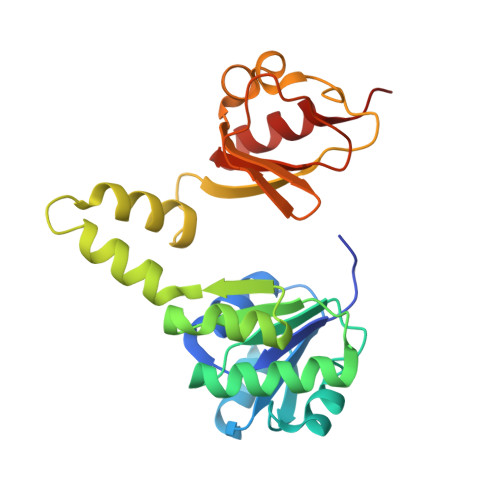Structures of the MthK RCK Domain and the Effect of Ca2+ on Gating Ring Stability
Dong, J., Shi, N., Berke, I., Chen, L., Jiang, Y.(2005) J Biological Chem 280: 41716-41724
- PubMed: 16227203
- DOI: https://doi.org/10.1074/jbc.M508144200
- Primary Citation of Related Structures:
2AEF, 2AEJ, 2AEM - PubMed Abstract:
MthK is a Ca2+-gated K+ channel from Methanobacterium autotrophicum. The crystal structure of the MthK channel in a Ca2+-bound open state was previously determined at 3.3 A and revealed an octameric gating ring composed of eight intracellular ligand-binding RCK (regulate the conductance of K+) domains. It was suggested that Ca2+ binding regulates the gating ring conformation, which in turn leads to the opening and closing of the channel. However, at 3.3 AA resolution, the molecular details of the structure are not well defined, and many of the conclusions drawn from that structure were hypothetical. Here we have presented high resolution structures of the MthK RCK domain with and without Ca2+ bound from three different crystals. These structures revealed a dimeric architecture of the RCK domain and allowed us to visualize the Ca2+ binding and protein-protein contacts at atomic detail. The dimerization of RCK domains is also conserved in other RCK-regulated K+ channels and transporters, suggesting that the RCK dimer serves as a basic unit in the gating ring assembly. A comparison of these dimer structures confirmed that the dimer interface is indeed flexible as suggested previously. However, the conformational change at the flexible interface is of an extent smaller than the previously hypothesized gating ring movement, and a reconstruction of these dimers into octamers by applying protein-protein contacts at the fixed interface did not generate enclosed gating rings. This indicated that there is a high probability that the previously defined fixed interface may not be fixed during channel gating. In addition to the structural studies, we have also carried out biochemical analyses and have shown that near physiological pH, isolated RCK domains form a stable octamer in solution, supporting the notion that the formation of octameric gating ring is a functionally relevant event in MthK gating. Additionally, our stability studies indicated that Ca2+ binding stabilizes the RCK domains in this octameric state.
- Department of Physiology, University of Texas Southwestern Medical Center at Dallas, Dallas, Texas 75390, USA.
Organizational Affiliation:
















